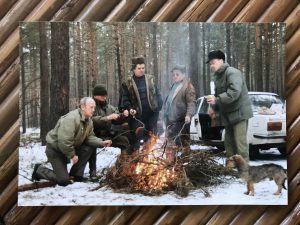My office wall has photos of over three decades of hunting, though the memories go back much further. In this series of posts I'm recounting some of the stories that go with them.

I acquired a PhD in Chemistry, so I am pretty much an authority on the subject matter. In order to make a fire you need three components: a combustible material, oxygen, and some way to overcome the threshold of energy required to let the two react; AKA a lighter, or a flint and steel, or a stick that you rub between your hands vigorously, or a lightning strike. For most people a lighter will do.
Oxygen is available, in varying quantities, depending on altitude, all across the globe. Combustible material, on a morning of hunting in a forest setting in an Eastern European country, two decades and a half ago, can also be called ubiquitous. That leaves component #3. Right? You had one job…
We headed out early that morning, sights set on pushing a few sections of forest. Not a big affair. Just my uncle, cousin, and myself carrying the rifles, my dad as independent observer, the local forest warden and his little Dachshund, and one of his friends with another dog whose progeny was hard to guess. We were hoping for wild boar, but expecting to settle for a roe deer. I think we got skunked.
But no room for despair or disappointment, because we were about to enjoy a good fire, and even better fresh-roasted sausages-on-a-stick, washed down with some questionable vodka. Con gusto we attended to the task of collecting one of the three prerequisites that would keep us from having to eat the sausages raw: fire wood. We were counting on the fact that oxygen would be available. OK, light it up!
Despite the language barrier it became clear fairly quickly that we had failed to provide for the third component of a good fire: the lighter. I gave up smoking when I turned twenty-one. My dad gave up smoking long before that, when he found out his father had lung cancer. My cousin only smoked a cigar or two at parties, and I’m not sure if my uncle ever smoked. And by some stroke of coincidence we were accompanied by the only two non-smoking males East of Berlin. Our situation was dire.
But wait! We came here by automotive vehicle. A vehicle contains fuel. That fuel is ignited by a spark. All we needed to do was to somehow combine spark and fuel, outside of the vehicle’s engine, and create a flame that was transportable to the wood pile, without blowing ourselves up. Hunger sparks ingenuity! Old newspaper was crumbled into a ball, doused in gasoline which was sucked from the tank through a rubber tube (standard emergency gear in Eastern European vehicles?), and the battery terminals disconnected, while those with more good sense than a sense of adventure (me) were busy sharpening sticks on which to impale the sausages, a fair distance away from the possible source of third degree burns.
It all worked beautifully! In no time we had the fire roaring, and the big sausages sizzling. We each had two. Fine sausages too, if I may be the judge, leaving us wanting nothing more. We then drove home where we drew the ire of the forester’s wife, who had prepared a big lunch meal for us. We tried our best. I don’t recall if there was any napping in the tree stand that afternoon, but there may have been.
F.